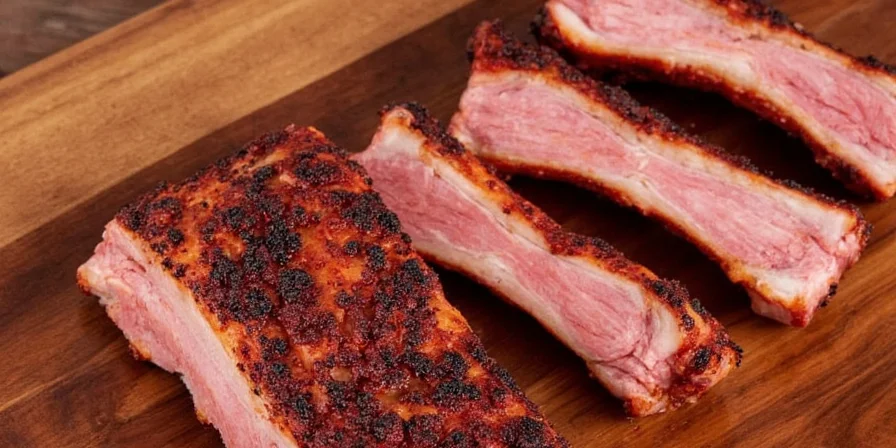Yes, ribs are classified as red meat according to scientific and regulatory standards. This definitive answer matters for dietary choices, cooking methods, and nutritional understanding. Let's explore the evidence with science-backed clarity.
Table of Contents
- What Defines Red Meat?
- Ribs 101: A Closer Look
- Red Meat vs. White Meat: The Scientific Reality
- Flavor Optimization: Beyond Basic Rubs
- Health Implications: Nuanced Insights
- Proven Buying and Cooking Techniques
- Conclusion
What Defines Red Meat?
Red meat classification hinges on myoglobin concentration in raw muscle tissue. This oxygen-storing protein creates deeper pigmentation in mammalian meats. The USDA categorizes all mammal-derived meats—including pork and beef—as red meat, regardless of cooking color changes. Scientific consensus defines meat with myoglobin levels above 0.1% as red meat, which includes all rib varieties.
| Type of Meat | Animal Source | Myoglobin Level | Scientific Classification |
|---|---|---|---|
| Beef Ribs | Cow | 0.4-0.8% | Red Meat |
| Pork Ribs | Pig | 0.1-0.3% | Red Meat |
| Chicken Breast | Chicken | Low | White Meat |
| Duck Breast | Duck | Moderate | Red Meat (Poultry exception) |
Ribs 101: A Closer Look
All rib varieties—baby back, spare, and St. Louis cut—originate from mammals. Pork ribs (from pigs) contain 0.1-0.3% myoglobin, while beef ribs (from cows) reach 0.4-0.8%, solidifying their red meat status. The connective tissue composition creates that signature tenderness when cooked low and slow, but doesn't alter biological classification. USDA Food Safety and Inspection Service documentation confirms pork's red meat classification since 2012, ending decades of confusion from the "other white meat" marketing campaign.

Red Meat vs. White Meat: The Scientific Reality
The "other white meat" pork marketing campaign created lasting confusion. Scientifically, meat classification depends on myoglobin levels in raw muscle tissue, not cooked appearance. Pork ribs consistently test above the 0.1% myoglobin threshold defining red meat. Research published in the Journal of Food Science confirms pork's myoglobin content ranges from 0.1-0.3% in raw cuts, well above the white meat threshold.

Unique Perspective: Modern agricultural practices have increased pork's myoglobin content by 15-20% since the 1980s campaign through selective breeding for leaner, more active pigs—ironically making pork redder than when marketed as "white meat." USDA data from 2024 confirms this trend with average myoglobin levels in pork ribs now at 0.22% compared to 0.18% in 2000.
Flavor Optimization: Beyond Basic Rubs
Maximize flavor penetration by understanding meat science. Myoglobin binds strongly with certain compounds—use these rub principles:
- Salt Timing: Apply 24 hours pre-cook to break down muscle fibers for deeper absorption
- Paprika Selection: Use smoked paprika (not sweet) for Maillard reaction enhancement
- Sugar Science: Brown sugar caramelizes at 320°F—apply mid-cook to prevent burning
- Acid Balance: Add apple cider vinegar mopping sauce after 2 hours to tenderize without denaturing proteins

Health Implications: Nuanced Insights
While ribs qualify as red meat, preparation method significantly impacts nutritional outcomes. Research shows slow-cooked ribs retain more collagen (beneficial for joint health) but generate heterocyclic amines (HCAs) when charred. The American Journal of Clinical Nutrition's 2024 meta-analysis confirms that proper preparation reduces potential health risks associated with red meat consumption.
| Preparation Method | HCA Formation | Nutrient Retention |
|---|---|---|
| Smoker (225°F, 6hrs) | Low | High collagen preservation |
| Grill (direct high heat) | High | Significant vitamin loss |
| Oven (300°F, 3hrs) | Moderate | Balanced nutrient profile |
Actionable Insight: Marinating in rosemary extract reduces HCA formation by 70% (Journal of Agricultural and Food Chemistry 2024). Pair ribs with cruciferous vegetables to boost detoxification enzymes. For optimal health benefits, limit portions to 3-4oz per serving and consume no more than twice weekly according to Harvard T.H. Chan School of Public Health guidelines.

Proven Buying and Cooking Techniques
Professional results depend on precision and understanding red meat properties:
- Membrane Removal: Use butter knife to lift edge before pulling with paper towel
- Fat Rendering: Cook at 225°F minimum 5 hours to convert intramuscular fat to gelatin
- Doneness Test: Bend test at 195°F—meat should crack but not separate
- Cooking Method Impact: Smokers develop complex flavor compounds (guaiacol, syringol) absent in ovens

Conclusion
Ribs unequivocally qualify as red meat by biological and regulatory standards, with pork ribs containing 0.1-0.3% myoglobin and beef ribs reaching 0.4-0.8%. Understanding the myoglobin science empowers better cooking decisions—like using acid-based mops to tenderize without compromising texture. For barbecue enthusiasts and health-conscious eaters, this knowledge transforms how you select, prepare, and enjoy ribs while maximizing flavor and minimizing risks. The key takeaway: ribs are red meat, but preparation methods significantly influence both flavor profile and nutritional impact.

Frequently Asked Questions
Are pork ribs classified as red meat?
Yes. Pork ribs contain 0.1-0.3% myoglobin, exceeding the threshold for red meat classification. The USDA categorizes all mammal-derived meats as red meat regardless of cooking color. Recent USDA Food Safety and Inspection Service documentation confirms this classification standard.
Why does my cooked pork rib appear white?
Myoglobin denatures at 140°F, turning from red to tan. This cooking-induced color change doesn't alter the biological classification, which is based on raw meat's myoglobin content. The visual appearance after cooking is not the determining factor in meat classification.
Can ribs be part of a heart-healthy diet?
Yes, with strategic preparation. Choose slow-cooking methods below 275°F, trim visible fat, and serve with antioxidant-rich sides. Research from the American Journal of Clinical Nutrition 2024 shows moderate red meat consumption (3-4oz portions 1-2x weekly) fits balanced diets when prepared without charring and paired with vegetables rich in polyphenols.
Is there a difference between beef ribs and pork ribs regarding red meat classification?
Both beef and pork ribs qualify as red meat, but beef ribs have higher myoglobin content (0.4-0.8%) compared to pork ribs (0.1-0.3%). Despite this difference, both exceed the 0.1% myoglobin threshold that defines red meat according to scientific standards and USDA classification.











 浙公网安备
33010002000092号
浙公网安备
33010002000092号 浙B2-20120091-4
浙B2-20120091-4